April 1, 2022
Air Date: April 1, 2022
FULL SHOW
SEGMENTS
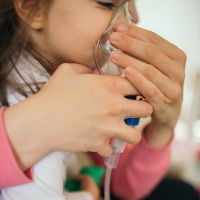
BPA Asthma Risk for Girls
View the page for this story
Higher levels of Bisphenol A (BPA) plastic exposure while in the womb are associated with increased risk of asthma and wheezing in school aged girls, a new study has found. Researchers measured exposure to BPA in pregnant women in Europe and then tracked their children for years. It’s the latest danger sign regarding the estrogen-mimicking component of some plastics that has been linked to numerous health problems. These types of chemicals are often used in plastic water bottles and food containers. Leonardo Trasande is a pediatrician who directs the NYU Center for the Investigation of Environmental Hazards and joins Host Steve Curwood to discuss. (13:45)

Conflict Oil and Gas
View the page for this story
Fossil fuel markets are often volatile, especially around wars, while renewable energy resources tend to be more isolated from conflict. And as oil prices surge the world stands on the precipice of a choice between even more climate-killing drilling and a transformational shift towards clean energy that could change the geopolitical landscape. Host Steve Curwood talks to Collin Rees, the U.S. Program Manager at Oil Change International about the state of global oil markets and what this moment means in the scope of the world’s dependence on fossil fuels. (14:14)

Beyond the Headlines
/ Peter DykstraView the page for this story
On this week’s trip beyond the headlines, Host Steve Curwood is joined by Environmental Health News’ Weekend Editor Peter Dykstra to discuss an ice shelf break-up in typically stable East Antarctica. Then, the two look at the promises of fast-food companies to get PFAS chemicals out of their packaging. Finally, the pair look back in history at how plastic pollution in the Indian Ocean complicated the search for debris from Malaysia Airlines Flight 370. (05:38)

The Quest for Climate Justice
View the page for this story
President Biden’s “Justice 40” initiative aims to deliver federal investments in climate protection and clean energy production to disadvantaged communities in places including the Gulf Coast. Communities of color there are disproportionately impacted by climate change and industrial pollution and appear to not receive as much support to rebuild after hurricanes as white communities. Beverly Wright, the Executive Director for the Deep South Center for Environmental Justice and a member of the White House Environmental Justice Advisory Council, joined Host Steve Curwood to talk about race and President Biden's Justice 40 initiative. (13:13)
Show Credits and Funders
Show Transcript
HOSTS: Steve Curwood
GUESTS: Collin Rees, Leonardo Trasande, Beverly Wright
REPORTERS: Peter Dykstra
220401 Transcript
[THEME]
CURWOOD: From PRX – this is Living On Earth.
[THEME]
CURWOOD: I’m Steve Curwood.
The case for alternative energy as an agent for peace.
REES: Western oil companies so Chevron, Exxon, Shell, Total, BP, and others have contributed almost 100 billion dollars to support Russia’s economy through taxes and other payments. When you hear talk about fossil fuels fueling Putin’s war machine, that’s not an exaggeration.
CURWOOD: Also, the fight for equal access to government help with climate related loss and damage, with a ground zero in New Orleans.
WRIGHT: We have lost much of what we gained before Katrina. All of our struggles you know have been lost and we are in a deeper, bigger fight with climate change looming over our heads trying to take everything else from us.
CURWOOD: That and more this week on Living on Earth – Stick Around!
[NEWSBREAK MUSIC: Boards Of Canada “Zoetrope” from “In A Beautiful Place Out In The Country” (Warp Records 2000)]
[THEME]
BPA Asthma Risk for Girls
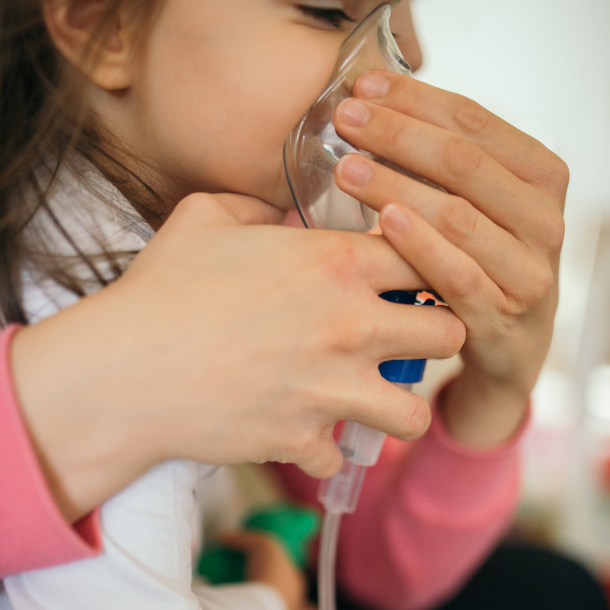
Exposure in the womb to bisphenol-A, or BPA, increases risk of asthma and wheezing in school-age girls, a new study from the Barcelona Institute for Global Health finds. (Photo: Nenad Stojkovic, Flickr, CC BY 2.0)
CURWOOD: From PRX and the Jennifer and Ted Stanley Studios at the University of Massachusetts Boston, this is Living on Earth. I’m Steve Curwood.
Girls have a higher risk of suffering from asthma if their mothers were exposed during pregnancy to a chemical called Bisphenol A, or BPA, which can be found in plastic water bottles and the linings of food cans. This new finding joins other studies linking BPA exposure to cardiovascular disease, type 2 diabetes, and disrupted brain development. BPA and similar chemicals can mimic estrogen and disrupt normal hormone functions, and apparently, as we now learn, lung development. Scientists led by the Barcelona Institute for Global Health measured exposure to bisphenol A in 3,000 pregnant women in Europe and then tracked their children for years. They found higher levels of BPA exposure while in the womb led to increased risk of asthma and wheezing in school aged girls, though not boys. Dr. Leonardo Trasande is a pediatrician who directs the NYU Center for the investigation of environmental hazards and does similar research. Dr. Trasande, welcome back to Living on Earth!
TRASANDE: It's a delight to be back, Steve, always.
CURWOOD: So this study led by a group in Barcelona, Spain, has linked Bisphenol A to asthma in school aged girls and not boys. This is a fascinating aspect of this study. What's going on here? What exactly did they find? And how did they get it?
TRASANDE: Well, they followed a large group of mothers and kids from across Europe, very carefully controlled studies that collected all sorts of data the same way in a consistent fashion that allowed them to then look at urine levels of bisphenols and relate that to lung function, as well as asthma in the kids as they follow them out now to the teenage years. I'll start by just emphasizing bisphenols are synthetic estrogens. They were actually considered as pharmaceuticals back in the 40s and 50s, when diethylstilbestrol came on the scene. Bisphenol A just wasn't strong enough as a pharmaceutical back then. So instead of the DES story, we could very well have had the BPA story, were it not for the potency of that estrogen. Now bringing it back to asthma, sex hormones shape lung development, just like inflammation can perturb growth and function of the lung buds. And during pregnancy, the lung buds are still forming, the number of them are still developing, they're branching out. And if you disrupt that development, that basic architecture, the consequences can be lifelong.
CURWOOD: So how fair is it to say that the bisphenol affects the expression of the genes that are being used to grow the lungs in a fetus? And that because sex hormones are a part of that swirl, in this case, it affects girls more than boys when it comes to long development?
TRASANDE: Well, we've got a ways to go to understand the full why we found this effect. This is an observational study, they weren't able to look as yet at the mechanisms underlying that. The way to really tease that out would be to look at genes as they are expressed at birth or in the children that have been followed over time. That's probably something that's underway. I know, in some of the participating cohorts in this study, they have that kind of data and are interested in looking into that. So we have some more work to do to figure out the exact mechanism. But that doesn't take away from the importance of the findings, and the fact that other studies have identified effects of bisphenol exposure on risk of asthma.

While the study focused on the effects of exposure to BPA in utero, bisphenols can be harmful to all of us at every stage of life, increasing risk of diabetes, obesity, and cardiovascular disease. (Photo: _steph_, Flickr, CC BY-NC-ND 2.0)
CURWOOD: So what's the significance of this study in comparison to the other research? And why should we pay attention to this particular study so much?
TRASANDE: Well, Steve, it's important to emphasize that this study followed populations of kids over time, whereas most of the studies before had looked at a cross section of a population, so that longitudinal design, with careful control of factors such as tobacco smoke exposure in utero, which is even more problematic for developing fetus and baby and then child, as well as other important factors that could otherwise have explained the effects. So, when you put the pieces together, this is a really important part of the jigsaw puzzle.
CURWOOD: So, the results of this study point to Bisphenol A, but there are other bisphenols, particularly after Bisphenol A came out of plastic drinking containers. Other forms of it, I think Bisphenol S is a popular one that got used. To what extent are all these bisphenols somewhat risky along these lines, that just going from Bisphenol A to say Bisphenol S for a container may not be so protective?
TRASANDE: We're constantly playing catch up in epidemiology and studying the effects of these populations, particularly in kids. And that's because we had for many years an "innocent until proven guilty" mindset when it came to chemicals in manufacturing. And when consumer attention to BPA came out in the late 2000s, companies raced to put "BPA- free" on their baby bottles and sippy cups, sounding responsive. But the fact is that we've had 40 or so artists formerly known as BPA, as I like to call it, in an omage to prints. And what little we know about some of these replacements suggests a "Whack-A-Mole" phenomenon where we've repeated the tale with BPA for BPS, Bisphenol S, just as an example. BPS is, by the way, as estrogenic, as toxic to embryos. And as if not more persistent in the environment. So unfortunately, the consequences we described in this study for BPA, may well repeat themselves as we follow later populations insofar as they're exposed to the same levels of BPS.

In 2012 and 2013, the Food and Drug Administration banned the use of BPA in baby bottles, sippy cups, and formula packaging. However, BPA is still present in many everyday items, such as metal cans and thermal paper receipts. (Photo: Sander van der Wel, Flickr, CC BY-SA 2.0)
CURWOOD: What I understand, BPA is found in all kinds of things, everything from a receipt that you might get at the grocery store, beverage containers, laundry detergents. Why are these chemicals so commonly used so readily available for people to be exposed to?
TRASANDE: The main word is plastic. Bisphenol is used as an ingredient in a variety of polycarbonate resins, as well as in some cases, epoxy resins. And those are used in a broad array of consumer products. Two of the major routes of exposure that you've described are canned food consumption, as well as thermal paper receipts. Many companies are saying that they've gotten bisphenols out of canned linings. The data are still missing, frankly, to really confirm that. I've asked the industry for that data. And we're hoping that, you know, in a transparent way we can get clarity that we're at least shifting away from bisphenols period, as a class.
CURWOOD: Now, this study that we're talking about links asthma and school aged girls to Bisphenol A. In the past, you've been involved with studies that show that high BPA levels in adults can be linked to what almost a 50% greater risk of death within 10 years. What was going on in that study?
TRASANDE: Well, these chemicals were not designed with the human body in mind. So you can imagine these free spirits, hacking all sorts of hormonal functions, that can have consequences for all of us. You know, kids are uniquely vulnerable, they drink more water, eat more food, breathe more air, they have developing organs, et cetera. But life is a window of susceptibility to these synthetic chemicals, and particularly for hormone function. So we did a study looking at a national data set called the National Health and Nutrition Examination Survey, and we looked at death certificates, linked those data to the measures of bisphenols taken a national survey in their urine, and found that they were more likely to die from heart disease over a 10 year period. That's also in the context of increases in obesity in adults, increases in diabetes in adults, by the way in relationship to Bisphenol A, as well as S, in that case. So you have a bit of a rap sheet, if you will, for these chemicals, when it comes to cardiovascular disease, because metabolism goes hand in hand with heart disease. So it's fair to say and summarize that these chemicals have a long and unfortunate storied history of the health effects that they can induce in all of us.
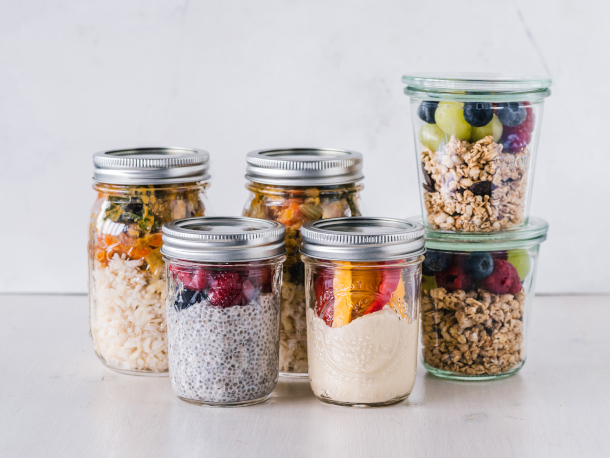
Our guest Dr. Trasande suggests that we need to rethink our relationship with plastics and return to glass and stainless-steel alternatives. (Photo: Ella Olson, Flickr, CC BY 2.0)
CURWOOD: You know I think about 10 years ago, the US Food and Drug Administration banned the use of Bisphenol A, BPA, in things like baby bottles and sippy cups and formula packaging. How do you think the government will react to this latest study showing greater risk of asthma among girls who were prenatally exposed to BPA? What kind of regulation do you think is needed? And what kind of regulation are you anticipating?
TRASANDE: I still rue the day where the Food and Drug Administration chose not to ban bisphenols in can linings, including BPA, when the evidence was clear enough to get it out of baby bottles and sippy cups. We've actually done a study a while back published in Health Affairs, where we describe the potential health and economic benefits of one safer alternative, such as oleoresin, which costs 2.2 cents a can, to use in these linings. And then what we did is to say, Okay, let's see if the cost of replacing all the cans in the US is $2.2 billion. What are the potential health and economic benefits on the other side of that balance? And we found in some scenarios, that the benefits of replacing BPA with something free of health effects, which is a big "if", was potentially greater, even six fold greater in certain scenarios. So this isn't just simply a health issue. It's an economic issue, because we all pay from the consequences. But to get to your point, Steve, I'm concerned that this finding won't move the needle and so much has already been described, though I'm always hopeful.
CURWOOD: So, in particular, what might a pregnant woman do to avoid exposure, to bisphenols, right now? I mean, what options do they have to keep their babies safe from this?
TRASANDE: Well, the good news is there are safe and simple steps all of us frankly, not just pregnant women, but especially pregnant women, can take to limit their exposure to hormone- disrupting chemicals. We've already alluded to canned food consumption. Fresh fruits and vegetables are a good alternative. You know, if frozen food is available, even those plastic containers pose lesser risk as long as they're not microwaved. If you take the fruits and vegetables out of those frozen containers, and put it, let's say, into a glass container before you heat it, or what have you. I would prefer pregnant women eat organic because there are benefits to avoiding pesticide exposure as well. In addition, we just need to really renegotiate our relationship with plastic. We've gotten lulled into the mantra of The Graduate, that plastics is the future. Plastics is really the past. And we need to switch back to glass and stainless steel. And particularly, we have to avoid microwaving, or machine dishwashing plastic. And the recycling numbers are important because you can avoid the plastics of greatest concern, if you must use plastic. The numbers to avoid are three, six, and seven. Three are for phthalates, which we haven't talked about, have their own effects on hormones. Six is for styrene, a known carcinogen, and seven are for the bisphenols, we've talked about.
CURWOOD: So what plastics are there to replace BPA in a safe way?

Consuming fresh fruits and vegetables as opposed to canned foods is another healthy way to avoid exposure to BPA. (Photo: Marco Verch, Flickr, CC BY 2.0)
TRASANDE: Well, that's a tall order. And the bio plastics had been touted as safe. But what little we know suggests that there are health effects on the endocrine system associated with chemicals that are found in those plastics. Some of this is difficult to accomplish, because companies can vouch that for food packaging materials that things are generally recognized as safe. So we as researchers have to go play catch up to figure out what's in the materials and what are the effects associated with the materials. There's a lot of material science that has to be considered because some things do absorb and some things don't. But the fact is, when you already have huge ecological consequences to plastic for fish, for wildlife, for frankly, water supplies, be it to the microplastics and macro plastics in our planet. We have to take a step back because we're also seeing this broader portfolio of problems directly related to our human health and the chemicals from plastic. So as much as people will tell me that there are safer plastics, the reality is we have to reduce our plastic use, period.
CURWOOD: Leonardo Trasande is a professor of pediatrics and director of the NYU Center for the Investigation of Environmental Hazards. Dr. Trasande, thanks so much for taking the time with us today.
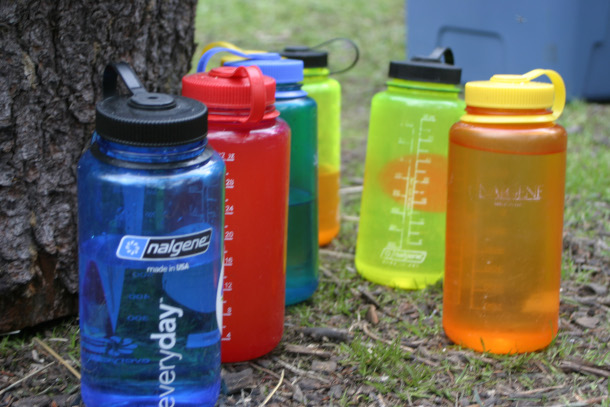
Alternatives to BPA should still undergo investigation by scientists, who often are forced to discover the health effects of chemical materials after they are already on the market. (Photo: Kyle LeBoeuf, Flickr, CC BY 2.0)
TRASANDE: It's always a joy talking with you, Steve. Thanks again.
CURWOOD: Our pleasure.
Related links:
- CNN | “BPA linked to asthma in school-age girls, study finds”
- Environment International March 2022 Journal 162 “In utero exposure to bisphenols and asthma, wheeze, and lung function in school-age children: a prospective meta-analysis of 8 European birth cohorts”
- CNN | High BPA levels linked to 49% greater risk of death within 10 years, study says
[MUSIC: Athletic Progression, “WHITE CRAYON” on Athletic Progression, HHV]
CURWOOD: Coming up – conflict fuels- the politics of oil and gas tied to Russia’s war in Ukraine. That’s just ahead on Living on Earth.
ANNOUNCER: Support for Living on Earth comes from Sailors for the Sea and Oceana. Helping boaters race clean, sail green and protect the seas they love. More information @sailorsforthesea.org. Support also comes from Friends of Smeagull the Seagull and Smeagull’s Guide to Wildlife. It’s all about the wildlife right next door to you! That’s Smeagull, S - M - E - A - G - U - L - L, SmeagullGuide.org.
[CUTAWAY MUSIC: Athletic Progression, “WHITE CRAYON” on Athletic Progression, HHV]
Conflict Oil and Gas
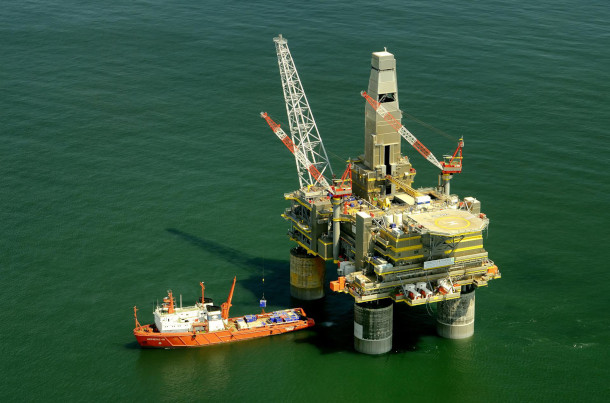
Russia’s oil industry has constituted around 40% of the nation’s GDP in recent years, and is key to funding its war against Ukraine. (Photo: Pixabay, Pixabay License)
CURWOOD: It’s Living on Earth, I’m Steve Curwood.
Even before Russia invaded Ukraine natural gas and crude oil prices started surging as global markets reflected the risks. The fossil fuel market is often volatile, especially around wars. The Arab oil embargo in 1973 after the Yom Kippur war between Israel, Syria and Egypt led to sky high prices at the gasoline pump in the US as Middle Eastern oil was cut off from the US and other countries that helped Israel. Today the US itself is reducing supplies with an oil embargo against bellicose Russia, with price shocks again hitting US filling stations. Renewable energy, on the other hand is steady as, well, the sun. Renewables produce clean, domestic, energy with fuel supplies isolated from conflict and the turbulent whims of international markets. So, in this unique moment in oil politics, Collin Rees, the U.S. Program Manager at Oil Change International, argues that we stand on the precipice of a green-energy revolution, and He joins me now for more, hi there!
REES: Thanks so much, Steve. It's great to be here.
CURWOOD: So last week when he was in Europe, President Biden got together with essentially the head of the EU Ursula von der Leyen and made this pledge that the United States is going to step up with natural gas for Europe. How could that be done? How possible is that and how advisable is that?
REES: Yeah, I think the biggest question and the one that was pretty unclear in last week's announcement was that we don't know if this means they will actually expand production and build new LNG and the gas infrastructure, or if it will be shifting existing capacity. Right now, we send a medium amount of gas and LNG to Europe, the US exports quite a bit more LNG and natural gas. And a lot of that goes to Asia, some of it goes to Latin America, some of it goes to Africa. And so, provided that other countries are willing to be flexible, or to shift a little bit, one thing the United States could do is shift some of those exports from other countries and send them to Europe instead. None of this is an ideal situation, but that would be the best option in our mind, because what the climate cannot afford is to build new long-lived infrastructure. So I think the biggest danger of this announcement was if it locks in new production.
CURWOOD: So by the way, how much natural gas are the Europeans looking for? I mean, what difference out of our current natural gas production would the U.S. be able to make?
REES: Yeah, the announcement talked about both a short term and a long term goal. There is talk of increasing capacity by 15 billion cubic meters of gas by the end of the year, and then securing commitments for an additional 50 billion cubic meters per year by the end of the decade. So that's a short and medium-term goal, it would be an increase of I think, around 30 to 40% from our current levels. There is a great analysis that recently came out from E3G and and a couple other think tanks showing that Europe could meet I think two thirds of that goal purely through energy efficiency and clean energy and aggressively trying to reduce demand for natural gas over the next few years. Make sure supply lines run a little differently but then we wouldn't have to be building out new long lived infrastructure.
CURWOOD: Now talk to me about the international oil markets here. The US is currently a net exporter of oil. And yet some say that we're dependent on foreign oil. Explain what's going on there.
REES: Yeah, when we talk about energy independence, it's not really a frame that makes sense. That is a frame that has been invented by the oil and gas industry and Republicans and as well as democratic boosters of the fossil fuel industry. It's an extremely connected global market. Prices are set on the global markets. We couldn't insulate ourselves from the natural volatility and boom bust cycle of the oil and gas industry. The other specific piece here is that the US imports a medium amount of oil. And part of the reason that is done is two reasons. One is it's actually a lot easier to ship in a little bit of oil from Asia over the Pacific Ocean, if you're talking about oil that's needed in Alaska, or Hawaii, or parts of the West Coast. And the second and perhaps more important reason is what we as the US tend to export is heavier crude oil, which needs more refining. What we tend to import is lighter crude oil that needs less refining, and is used for slightly different uses. So it's not simply that all oil is created equally. And that we can immediately switch between different uses. It's actually different types of oil that we don't necessarily produce in the same amounts as what we need.
CURWOOD: In other words, in the U.S. we make beer and then overseas, they make wine?
REES: That's one way to think about it.
CURWOOD: So by the way, what kind of money are we talking about for Russia when it comes to oil and gas? How big are the numbers for them? And therefore, how important are these boycotts of Russian oil and gas?
REES: When you hear talk about fossil fuels fueling Putin's war machine, that's not an exaggeration. Fossil fuel revenue has ended up around 40% of the Russian budget in recent years. Oil Change recently put out a piece of analysis with Greenpeace USA and Global Witness showing that Western oil companies so Chevron, Exxon, Shell, Total, BP and others have contributed almost $100 billion to support Russia's economy through taxes and other payments via oil and gas operations over the last decade, or since the invasion of Crimea. So these boycotts, they are about isolating Russia on the global geopolitical stage. If it does succeed in actually limiting the ability of Russia to export these fossil fuels, that would be a game changer in terms of the money that's actually flowing to Russia.
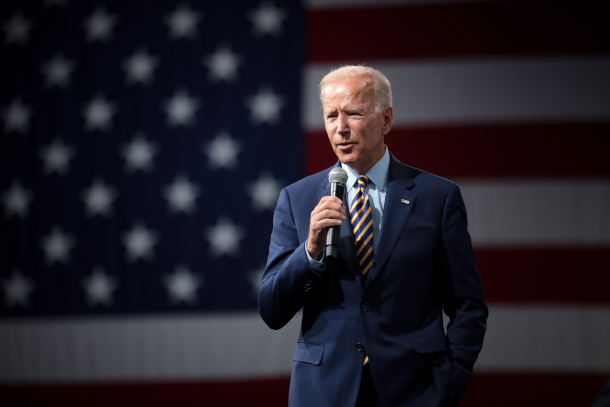
The Biden administration has opened the Strategic Petroleum Reserve in a bid to dampen the impact of high prices at the gasoline pumps, and is calling for the domestic fossil fuel industry to increase output over the near term. It remains to be seen how the administration’s policy will impact the industry in the coming years and efforts to reduce climate changing emissions. (Photo: Gage Skidmore, Flickr, CC BY-NC 2.0)
CURWOOD: Some say that natural gas is a better deal than coal or oil. Others say that leakage of methane associated with the production and transportation of natural gas wipes out any advantage there. What do you say?
REES: So there are two reasons that natural gas is not any sort of bridge fuel. The first is methane leakage. Methane is a very potent and powerful fossil fuel. And in practice, as you mentioned, methane leakage is a severe problem around the world. And it's also something that's very difficult to measure. Even in the US, we have almost no idea how much methane is actually escaping along the natural gas supply chain. It happens at essentially every stage of transportation that some amount of methane leaks out, and if more than 3% of the methane leaks out, it ends up erasing the climate benefit of natural gas. We just saw a study from the New Mexico Permian Basin one of the largest sources of gas and oil here in the United States, which preliminarily showed that it could be as high as 9% leakage at different spots. The second piece here is that we are so deep in the climate hole just being better than coal isn't actually sufficient. We have done a lot of analysis at Oil Change International, the International Energy Agency has confirmed that we can't afford any new fossil fuels. And so even if we were to assume zero methane leakage, new natural gas still would be bursting our carbon budgets.
CURWOOD: Let me ask, where does Chinese demand fit into the world energy markets now?
REES: Chinese demand is increasing at a pretty substantial rates. China and other countries in East Asia have been some of our largest clients for U.S. natural gas over the last few years. And also from Russia. They've increased their imports of Russian oil and natural gas over the last few weeks. In some ways, they think they've not taken the political stance that other countries and countries in the West in particular have and continue to import fossil fuels from a pretty wide variety of sources around the globe.
CURWOOD: What about Iranian oil? It's been blocked from the market by the U.S. with sanctions, but under the present conditions, where do you think it might be going?
REES: One of the biggest discussions that's going on right now is how to handle the oil coming out of traditional U.S. enemies, I'll say, at least for the last couple of decades, places like Iran, places like Venezuela. The Biden administration has been in contact with the governments of those places, there's discussion of more of their oil to go to places like Europe. This is a moment in which there's potential to reshape existing diplomatic relationships. One of the big questions is, how does this impact Iran's relationship with other oil exporting states in the Gulf, the Persian and Arabian Gulfs? Those are sort of the questions that we're seeing right now.
CURWOOD: It's a bit of the enemy of my enemy is my friend?
REES: That's exactly what we're seeing. I think it's laying buried how in fact, it's not necessarily deeply rooted in a moral argument, it's convenient for the U.S. to be opposed to these countries until they really need what they have.
CURWOOD: So somebody listening to us right now might want to know why is what happens in Russia makes prices at the pump for gasoline in California rise? What exactly happens in a situation like that?
REES: The price of gasoline in a place like California is dependent on a number of factors. One of those factors is the actual acquisition of the crude oil. Another is the cost of refining that oil. And then you have a couple different levels of taxes. Some of those things have remained constant, there hasn't yet been a big change in the gas taxes, for instance, at the state or federal level, though that's being discussed. Refining prices have increased slightly due to overall inflation due to a labor shortage, it's important to remember that oil prices were already relatively high and increasing before the invasion of Ukraine. But the biggest component here is the global price of oil and how much it costs to obtain a barrel of crude oil. And so that's the piece that we've seen increase significantly in the last few weeks. Part of that is because increased demand for non-Russian oil has caused prices to increase a little bit. The other thing is investor fear. Markets run a lot, not just on physical realities, but actually on on fear and kind of assumptions what might happen next. There is a fear that this tragedy in Ukraine could continue to unfold for some time that this is not going to be a short term blip. And so I think prices have adjusted quite a bit higher in response.
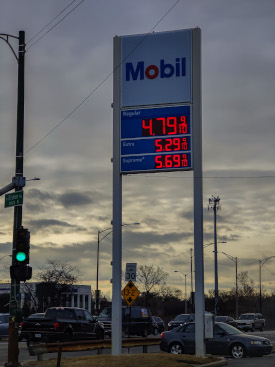
Gas prices reach new highs all across the U.S., with some regions paying close to $6 per gallon. (Photo: Don Harder, Flickr, CC BY-NC 2.0)
CURWOOD: What kind of policies do you think the Biden administration should be advancing to reduce the demand for gasoline, as well as natural gas, because it is such a sensitive place for consumers and people on limited incomes to encounter?
REES: I think the most important thing to understand is that the fossil fuel industry is trying to use this as a moment to boost their own profits and to lock in a future for themselves. Essentially, what we're seeing right now is that even as oil prices have come down, gasoline prices have not followed them. We're seeing oil companies raking in massive record profits, those profits are of course not being passed along to consumers. And I think that's, that's a scandal. That's an outrage to the American people. So I think one important thing that's been introduced in Congress in the U.S. there's been discussion in other European countries as well, but is essentially a tax on the hundreds of billions of dollars that the fossil fuel industry is making while working people are still suffering. And then I think that is money that could be targeted at low-income consumers could be used to fund the build out of more equitable transportation infrastructure to make electric vehicles cheaper. And then the second thing is sort of related to that. The Biden administration has a lot of executive power that it hasn't really used yet to do things like ramp up the production and adoption of renewable energy technology and of energy efficiency technology. This is something that President Trump wasn't hesitant about using. In cases of emergency the Biden administration shouldn't be either.
CURWOOD: Now there have been some who say that should to green energy will push things towards protectionism as there is competition among the green power countries. What geopolitical shifts do you think we should look for from a global transition away from fossil fuels and oil to green renewable energy?
REES: I think we've seen a system in the fossil fuel industry in which power is very concentrated in the hands of just a few specific companies, we have an opportunity to produce a system in which many more energy-producing systems are actually owned by the communities in which they operate. You have local solar panels and low solar arrays. These are us examples. But there's even more potential, particularly in Africa and Southeast Asia, to build out much faster and cheaper access to energy by using renewable energy. These are the sorts of things I think we should be focused on at the structural level. And the other piece to this is that we don't want to be extracting the raw materials required for renewable energy in negative ways. We don't want to be creating sacrifice zones. We don't want to be making the global south yet another extraction zone for Imperialism, as we've seen in the past.
CURWOOD: What role if any, do you think nuclear power should play in this shift away from fossil fuels?
REES: I think it's entirely reasonable to recognize that it might have some benefits in the short and medium term. But to recognize that on the long term, new nuclear doesn't make any sense. New nuclear is prohibitively expensive, it is vastly cheaper and faster to build out renewables technologies, and we have those technologies available now.
CURWOOD: Of course, the nuclear crowd would say, renewables are intermittent, we don't have the storage yet really effectively. So nuclear over the short or medium term does offer relatively carbon-free baseload power. And you say?
REES: I would say intermittency is not nearly as much of a problem for renewables as it was a decade ago, we have advanced and rapidly advancing battery technology. And so I think that's the sort of thing that our subsidies should be going to.
CURWOOD: Collin, with the pandemic, Russian invasion of Ukraine, and other shifts in the world. Some say this is an inflection point in our species's history, looking at the world of energy over the medium and long term, what are you hoping for? What are you concerned about?
REES: I think this is a moment in which the world will decide whether we are going to step up and meet the climate crisis, or whether we are going down a path of drastically increased climate impacts, increased climate displaced peoples and migration as a result of the climate crisis, further tethering our economies to the volatility of things like oil and gas and conflict. In particular, I think we've seen in recent years for the first time countries get serious about talking about ending finance for fossil fuels. We saw in COP 26 at Glasgow, the launch of the Beyond Oil and Gas Alliance: the first dedicated alliance of global governments committing to actually stop the expansion of the supply of fossil fuels. We need to be reducing both demand and supply in tandem, and this is the first sign that global governments are agreeing. So I think the big question is, will that momentum to address both the demand and the supply of fossil fuels together, continue or will something like this tragic invasion of Ukraine throw it off course?
CURWOOD: Collin Rees is the US Program Manager for Oil Change International. Collin thanks so much for taking the time with us today.
REES: Thanks, Steve. It was great to be here.
Related links:
- Oil Change International website
- Collin Rees’s Oil Change International publications
- Find Collin Rees on Twitter
[MUSIC: Jazz at Lincoln Center Orchestra with Wynton Marsalis, “Be Present” on The Democracy! Suite, Jazz at Lincoln Center, Inc.]
CURWOOD: Coming up – We check in on the Justice 40 initiative of President Biden, his pledge to ensure disadvantaged communities benefit from federal investments in climate resilience. That’s just ahead on Living on Earth.
ANNOUNCER: Funding for Living on Earth comes from you, our listeners, and United Technologies, combining passion for science with engineering to create solutions designed for sustainability in aerospace, building industries, and food refrigeration.
[CUTAWAY MUSIC: Jazz at Lincoln Center Orchestra with Wynton Marsalis, “Be Present” on The Democracy! Suite, Jazz at Lincoln Center, Inc.]
Beyond the Headlines

East Antarctica is typically seen as very stable; the recent ice shelf break up is the first humans have ever observed in the half-century since satellites began to imaging Antarctica. (Photo: NASA, Public Domain)
CURWOOD: It’s Living on Earth, I’m Steve Curwood.
And on the line now from Atlanta, Georgia is Peter Dykstra. Peter's an editor with Environmental Health News, that's EHN.org and DailyClimate.org. And he's here to tell us what's going on beyond the headlines. Hi there, Peter. How you doing?
DYKSTRA: Well, hi, Steve. We got some foreboding news this past week from East Antarctica, considered to be the most stable region in the face of climate change of either the Arctic or the Antarctic. An ice shelf the size of New York City collapsed in East Antarctica. And that can only mean bad news for the contributions of the Arctic and the Antarctic, to global warming or climate change, or whatever we want to call it. But it's a crisis.
CURWOOD: Yeah. And it's funny this happened right around the equinox, the sun shining equally on the southern hemisphere, and the northern hemisphere in the polar regions. And there were heat waves in both places, Peter at this time.
DYKSTRA: Up to 70 degrees Fahrenheit warmer than normal in parts of Antarctica. And less than that, but still near-record setting warmth in the Arctic at the end of the Arctic winter.
CURWOOD: And of course now this is the collapse of an ice sheet already on the water that's not going to raise sea levels. But this trend continues, the glaciers behind it, that's not good news, Peter. Maybe you have something to cheer me up?
DYKSTRA: Well, if you're a fast food consumer, and I'm not saying that you are: Burger King, and Chick-Fil-A committed to removing those so called forever chemicals from their food packaging. Restaurant Brands International, which is the company that owns Burger King, and Popeyes, and Tim Hortons, those delightful doughnuts from Canada, announced plans a week ago to eliminate both per- and polyfluoroalkyl substances, the ones we know as PFAS, from all consumer packaging by the end of 2025.
CURWOOD: Hey, Peter, my excuse for hitting those fast food places: you know, as a reporter out there doing journalism and you're there late at night and guess what's open late at night or the first thing in the morning?

Several fast-food corporations have made commitments to removing PFAS and other toxic chemicals from their packaging. (Photo: Marco Verch, Flickr, CC BY 2.0)
DYKSTRA: Yeah, I'm a bit of a hypocrite too, because we know the different ways that particularly consumption of beef can hurt our global climate as quickly as it can hurt our own bodies. There are other firms that have been on top of this as well. McDonald's last year, said that they had eliminated quote a significant subset of PFAS in its packaging. They committed to removing it all by 2025. And a couple of years ago, Taco Bell made a similar pledge, stating that quote, PFAS, phthalates and Bisphenol A will be removed from all consumer facing packaging materials,
CURWOOD: Which of course leaves open what happens in the kitchen and in the back office. Now, PFAS chemicals aren't good for us. They're associated with cancers and low birth weight and and that sort of thing.
DYKSTRA: All manner of reproductive issues, as well as some types of cancer. We're finding out just how damaging they are. We're also finding out just how absolutely ubiquitous they are in the supply chain for so many food products.
CURWOOD: Well, Peter, I'm waiting for you to tell us a story as to how we can get that stuff out of our bodies. But for now, take a look at your history books there and tell me what you see.
DYKSTRA: We're only going back eight years for an item that you'd be surprised has such a big environmental connection. But in March 2014, Malaysian Airlines Flight 370 went down over the Indian Ocean, triggering an absolute frenzy of searching and an equal frenzy in the media. But then on April 2, 2014, the searchers for the wreckage of Malaysian Flight 370 reported a new problem. Radar and satellite imagery couldn't distinguish between all of the routine floating garbage we had put in the Indian Ocean and the floating garbage that could indicate the wreckage of a Boeing 777 aircraft. It's a troubling precedent for search and rescue. It's another troubling precedent, for that matter, for ocean-borne garbage. And to me, it's just one stunning way that we've managed to fill the oceans with our own garbage.

Malaysia Airlines Flight 370 went missing in March of 2014, and search-and-rescue efforts were stymied by an overabundance of marine garbage. (Photo: Laurent Errera, Wikimedia Commons, CC BY-SA 2.0)
CURWOOD: Right, and a lot of it that's floating there is made from plastic, which comes from fossil fuels, and we also have a bunch of carbon dioxide garbage in the atmosphere from the burning of fossil fuels. One has to wonder how helpful fossil fuels are for our civilization these days.
DYKSTRA: Well, consider this. It was only a quarter century ago that we began to realize that the oceans were suffering from those two things. We thought the oceans were much too huge for little old us to pollute them with garbage or acidify the oceans with fossil fuel deposition, particularly from coal. But both of those things have revealed themselves to be serious problems as we look to the future environmental health of Earth.
CURWOOD: Okay, Peter. Well I'm looking for a fossil-free, PFAS-free and Arctic friendly burger someplace.
DYKSTRA: Make mine to go.
CURWOOD: Peter Dykstra is an editor with Environmental Health News, that's EHN.org and DailyClimate.org. We'll talk to you again real soon.
DYKSTRA: All right, Steve. Thanks a lot. We'll talk to you soon.
CURWOOD: And there's more on these stories at the Living on Earth website. That's LOE.org.
Related links:
- AP News | “Ice Shelf Collapses in Previously Stable East Antarctica”
- KTLA 5 | “Fast-Food Chains Vow To Nix ‘Forever Chemicals’ Found In Wrappers”
- The Christian Science Monitor | “Malaysia Airlines Flight MH370: Search Reveals Extent of Ocean Garbage”
[MUSIC: Wynton Marsalis “Soon All Will Know” on Marsalis Standard Time – Volume 1, Sony Music Entertainment Inc.]
The Quest for Climate Justice
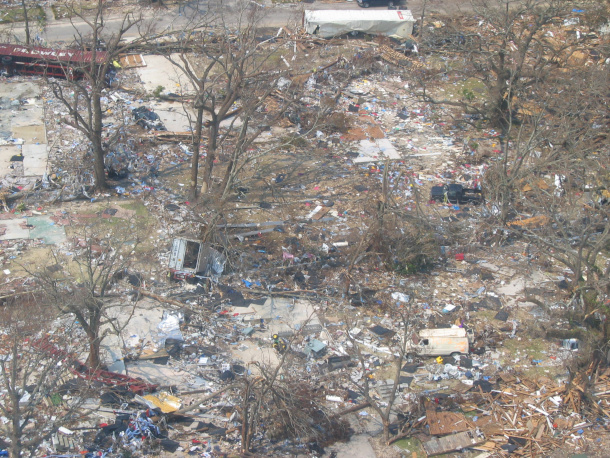
Hurricane Katrina was a large and destructive Category 5 Atlantic hurricane that caused over 1,800 fatalities and $125 billion in damage in late August 2005 when it came ashore in the Gulf Coast. Even though wind speeds had slowed down when Katrina hit New Orleans failures in the levee system and pumping stations compounded the disaster. Photo: News Muse, Flickr, CC BY-NC-ND 2.0)
CURWOOD: Shortly after taking office President Biden launched his “Justice 40” initiative which aims to deliver to disadvantaged communities 40 percent of the benefits of federal investments in climate protection and clean energy production. Justice 40 is a step towards supporting the communities often most impacted by climate change but with the least resources to adapt. The Gulf Coast is a prime example. Hurricane Katrina, fueled by a warming ocean, leveled parts of poorly protected New Orleans and since then another 10 hurricanes have hit the region. Beverly Wright says communities of color are not being supported to rebuild in the same way as white communities. She is the founder and Executive Director for the Deep South Center for Environmental Justice as well as a member of the White House Environmental Justice Advisory Council that’s working to fulfill President Biden’s Justice 40 initiative. Beverly Wright, Welcome back to Living on Earth!
WRIGHT: Thank you, Steve. Great to see you again. It's been a long time.
CURWOOD: It has Dr. Wright. And it's been some 17 years since Hurricane Katrina hit Louisiana and exposed deep environmental justice issues. Tell me about what progress has been there so far.
WRIGHT: Well, as is always the case, you know, we've made steps forward and we've made steps backwards. We've lost population, mainly because of the infrastructure not being in the shape it needs to be in for people to return. We've had gentrification at warp speed. Whole neighborhoods that were formerly historically Black being gentrified at a rate that's unbelievable. Even Treme where Louis Armstrong grew up, you now see white people walking everywhere and black people displaced. They've been pushed out to the New Orleans suburb, New Orleans East where I live, in a place where there are no amenities for them, no bus service, that will allow them to get back in town to work. So New Orleans people are resilient and in spite of everything that's been here to deter are remaining, including climate change, which is kicking our butts. Last year, we had five hurricanes in one year. And right now it's trying to recover from Ida, that's the latest hurricane that hit our city. You compound that with insurance rates going through the roof. So we're in a conundrum. We're in a conundrum because of the oil industry and its impact on climate change. Because the oil industry produces PM 2.5, which is a air pollutant and so our mortality rate was higher than others, due to COVID and it had everything to do with air pollution. So if I wanted to talk about some lessons learned, there are some huge lessons that we're learning.
CURWOOD: By the way, what happened to the money became for recovery funding after Katrina? What happened when it came to black and white neighborhoods there in New Orleans?
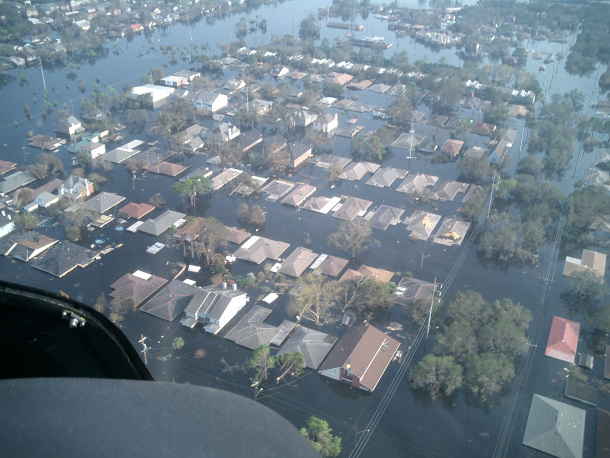
When Hurricane Katrina hit Southeast New Orleans on August 29, 2005, Category 1 range winds and storm surges caused approximately 23 breaches in the drainage canal and navigational canal levees and floodwalls. (Photo: News Muse, Flickr, CC BY-NC-ND 2.0)
WRIGHT: Okay, well, my center actually did a study of where the money went. So the city of New Orleans probably has gone through more design charettes, than any other city in the United States. And we came together to talk about how we wanted our city to recover and what development projects should we put in place. Well, when we looked at where the money was spent and compared that by each wards of the city, what we found was that the only wards that got what they wanted, were the wards that were wealthy white people and the downtown district. The communities that were hurt the most, got only a very small portion of the monies for recovery. And there's some other really strong data that came out that ended up in a lawsuit where the Road Home Project actually gave more monies to white people to rebuild their homes than they did to black people. And that was certainly connected to systemic racism, because they devalued our homes because of the formula that was put in place. And let me explain what that formula was, the formula said that you would get monies based on the lesser of two variables, that is the cost to rebuild your house and the assessed value of your house. And so the assessed value of the same house in a black neighborhood, versus a white neighborhood was many thousands of dollars off. So if you were given the amount of money for the assessed value of your house, that didn't change the cost to rebuild your house, whereas white communities had their assessed value, and the cost to rebuild being the same, whereas we did not. That meant that large numbers of black people in this city did not get enough money to rebuild their homes. We sued. We sued the Road Home Project and won. But you know what happens when you sue and win we had to get the judges to stop the spending of the money because all the money would've been gone. But what was left certainly was not enough to repair the damages that had been done. So you get that consent decree. And it's like, you know, do the wrong thing. You know, it's wrong, wait to be told not to do it. And then you go into some consent decree based on the amount of money left.
CURWOOD: Beverly Wright let's talk about the Infrastructure Investment and Jobs Act sometimes called the Bipartisan Infrastructure Bill that President Biden signed last year. And now White House will say this is a great chance to have transformational environmental legislation go to work. What does the Deep South Center for Environmental Justice support in the bipartisan infrastructure framework and for that matter, the Biden administration accomplishments so far?
Biden wants to spend infrastructure billions on climate and equity initiatives. But it’s not his call..https://t.co/4ZDSxsAWHr @politico #Justice40
— Robert D. Bullard (@DrBobBullard) March 25, 2022
WRIGHT: Well, I'm of mixed emotions on the bipartisan infrastructure bill. I think overall, you know, it's a really smart attempt at transforming this country, from fossil fuels to renewable energy. I think that our biggest concern is implementation, how these dollars are going to be spent. While the bill itself is a great bill, you know, we'd like to see more money be placed on what we call legacy communities, communities that are built on top of superfund sites. And if we're talking about transformation or transforming to renewable energy, this is a wonderful place to begin moving people off of these toxic land, building the land back up to a level for industrial use and putting some of planet fields, solar fields on those lands. And there's no limit to the wonderful ideas that we are pushing forward for this transformation process, but we always think about implementation. The Environmental Career Worker Training Program that exists for example, at NIHS is a great program that teaches young people, it trains them in hazardous waste worker field, with remediation of lead and asbestos and all of these things. That same program now we're trying to advance to include training in the construction of solar panels, and hydro, and wind. Making certain that our populations are trained to meet the challenges of this new renewable society that we're trying to move into. And we're prepared for the enormous amount of jobs and wealth that could come with that training.
CURWOOD: And let me ask you about the White House Environmental Justice Advisory Council. WHEJAC is what it's known as. What's the purpose of it, and what has it accomplished so far?
WRIGHT: So the White House Environmental Justice Advisory Council had three main objectives, we were given three objectives. The first was the implementation of Justice 40, the development of what we call a scorecard, that is to be able to judge whether or not the different agencies were meeting the 40% goal that is 40% of benefits for any renewable projects going to EJ and climate impacted communities. We're supposed to also develop a screening tool that would be the tool that's used to define the communities that should benefit from the Justice 40 implementation. And the fourth was to strengthen the Executive Order 12898. And one of our problems is that this particular factor falls under CEQ. CEQ (Council on Environmental Quality) has about maybe 10 People working in that office to implement a nationwide plan. And so they're terribly underfunded and working on the WHEJAC, we find that we are under resourced. And we have no contractors. We're all doing this on our own.
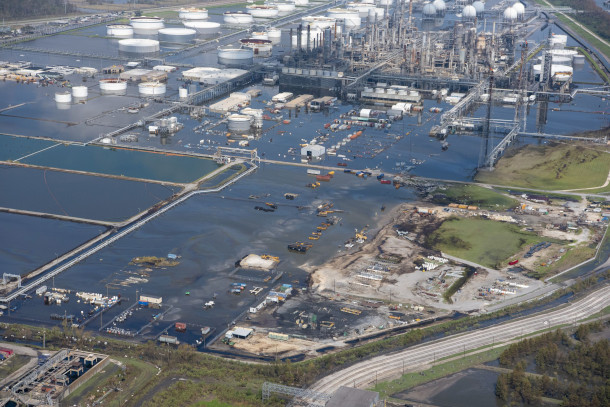
The Coast Guard conducts an overflight of a flooded oil refinery for potential pollution threats and environmental impacts from Hurricane Ida Sept. 3, 2021, in Belle Chasse, Louisiana. (Photo: Petty Officer 2nd Class Ryan Dickinson, U.S. Coast Guard, Flickr, CC BY-NC-ND 2.0)
CURWOOD: CEQ stands for the Council on Environmental Quality, the White House Council on Environmental Quality?
WRIGHT: Yes.
CURWOOD: That's what you're referring to. 10 people work there. Only 10 people work there?
WRIGHT: Yeah, it's a very small staff. And it has been overwhelming for them. You know, and needless to say, the workload for us is quite amazing. And so I believe that at this point, we're taking a new look at, you know, the weight, the organizational structure of our work in relation to CEQ. Making suggestions about how we should reorganize this, put more resources and people into this process. And there's a game plan already in existence that could be utilized and and it's certainly one that the federal government uses in other spaces.
CURWOOD: Beverly Wright talk to me about the Gulf Coast region. I mean, your part of America has seen environmental disaster after catastrophe after disaster and of course, the toxic pollution from the petrochemical industry there, especially in the Lower Mississippi, but then of course out into the Gulf of Mexico. What opportunity does the Biden administration have to change that?
WRIGHT: Oh, wow. Well, I you know, if all people in this country was seen as equal a lot of the stuff that we've done, we would do differently. In other words, there would be no Cancer Alley per se, because we would have moved forward more carefully to protect the health of our citizens. We've done a good job of trying to protect the health of some people making certain that their environment is clean, making certain that nothing nasty or dirty goes in certain places where certain people live. Imagine what a different world it would be if in fact, we did things differently. So I think that President Biden has, in so many ways, talked about environmental justice and making certain that that is at the forefront of many of his speeches and even parts of his platform. But finding a way to implement all of the unbelievable projects that he has put in place, is still now in danger of not happening because of racism. And you take a simple thing like in the screening tool, not allowing race to be a factor. So the whole reason for Justice 40 is because of race. The racially disproportionate impacts of environmental pollution and climate change on communities because of their race. But then he puts a program in place to deal with that, but you can't use race as a factor. So we're left to turn ourselves into pretzels, trying to find other ways to make certain that Black people in particular are included in the screening tool. So you come up with something like linguistics, great, but that doesn't affect Black people. Even when you use income, you know, middle and upper income Black people breathe more pollution than a white person that that earns $10,000 a year. So the income variable is blown. But once again, the lawyers step in and you know, they say, because there's money attached to this, you cannot use race as a reason to put monies into programs. So we're forced again in this racist society to deal with racist ideologies that stop us from really dealing with the race problem.
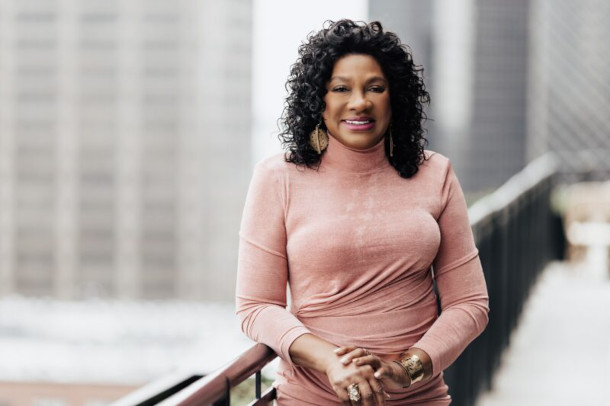
Beverly Wright is the founder and Executive Director for the Deep South Center for Environmental Justice as well as a member of the White House Environmental Justice Advisory Council. (Photo: Courtesy of the Deep South Center for Environmental Justice)
CURWOOD: Dr. Beverly Wright is the founder and executive director for the Deep South Center for Environmental Justice. Thanks so much for taking the time with us today.
WRIGHT: Thanks, Steve.
Related links:
- Learn more about the White House Environmental Justice Advisory Council
- Our Time Press | “Dr. Beverly Wright, Environmental Justice activist and scholar, appointed as an advisor to The White House”
- Learn more about the Deep South Center for Environmental Justice
- Watch the Second Annual Hazel Johnson EJ Celebration Featuring Dr. Beverly Wright
[MUSIC: Wynton Marsalis, “New Orleans” on Marsalis Standard Time – Volume 1, Sony Music Entertainment Inc.]
CURWOOD: Living on Earth is produced by the World Media Foundation.
Our crew includes Naomi Arenberg, Bobby Bascomb, Paloma Beltran, Chloe Chen, Iris Chen, Josh Croom, Gabriella Diplan, Jenni Doering, Mark Kausch, Mark Seth Lender, Don Lyman, Louis Mallison, Aynsley O’Neill, Sophia Pandelidis, Jake Rego, Teresa Shi, and Jolanda Omari. Tom Tiger engineered our show. Alison Lirish Dean composed our themes. You can hear us anytime at L-O-E dot org, Apple Podcasts and Google Podcasts, and like us, please, on our Facebook page - Living on Earth. We tweet from @livingonearth. And find us on Instagram at livingonearthradio. I’m Steve Curwood. Thanks for listening!
ANNOUNCER: Funding for Living on Earth comes from you, our listeners, and from the University of Massachusetts, Boston, in association with its School for the Environment, developing the next generation of environmental leaders. And from the Grantham Foundation for the protection of the environment, supporting strategic communications and collaboration in solving the world’s most pressing environmental problems.
ANNOUNCER 2: PRX.
Living on Earth wants to hear from you!
Living on Earth
62 Calef Highway, Suite 212
Lee, NH 03861
Telephone: 617-287-4121
E-mail: comments@loe.org
Newsletter [Click here]
Donate to Living on Earth!
Living on Earth is an independent media program and relies entirely on contributions from listeners and institutions supporting public service. Please donate now to preserve an independent environmental voice.
NewsletterLiving on Earth offers a weekly delivery of the show's rundown to your mailbox. Sign up for our newsletter today!
 Sailors For The Sea: Be the change you want to sea.
Sailors For The Sea: Be the change you want to sea.
 The Grantham Foundation for the Protection of the Environment: Committed to protecting and improving the health of the global environment.
The Grantham Foundation for the Protection of the Environment: Committed to protecting and improving the health of the global environment.
 Contribute to Living on Earth and receive, as our gift to you, an archival print of one of Mark Seth Lender's extraordinary wildlife photographs. Follow the link to see Mark's current collection of photographs.
Contribute to Living on Earth and receive, as our gift to you, an archival print of one of Mark Seth Lender's extraordinary wildlife photographs. Follow the link to see Mark's current collection of photographs.
 Buy a signed copy of Mark Seth Lender's book Smeagull the Seagull & support Living on Earth
Buy a signed copy of Mark Seth Lender's book Smeagull the Seagull & support Living on Earth

